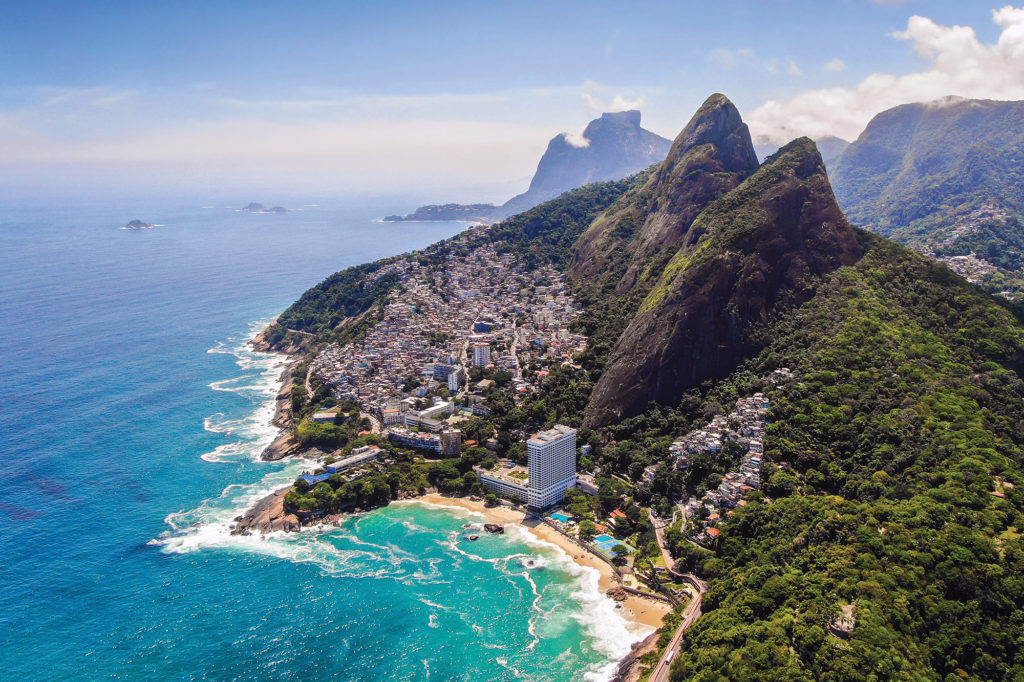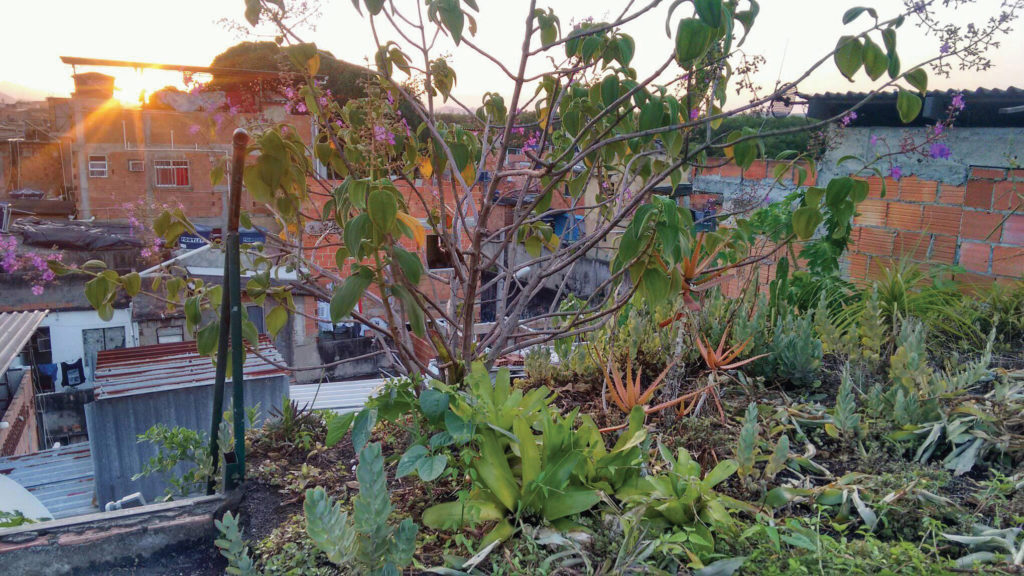Brazil’s Favelas: A model for Green architecture and sustainable living
December 14, 2021
Along with samba, beaches and the famous Cristo Redentor statue, the city of Rio de Janeiro in Brazil is home to some 1.5 million people who live in favelas1—densely populated settlements whose closest cousins in Southeast Asia might be referred to as shanty towns or slums. Favelas are largely a legacy of the end of slavery in Brazil, which occurred in 1881, as well as widespread rural unemployment. Thousands of Afro-Brazilians, along with farmworkers migrating to the city, created the informal settlements in order to be housed and to be close to job opportunities in the formal city2.

Aerial view of Two Brothers Mountain (Morro Dois Irmaos, Pedra da Gavea and Vidigal). R.M. Nunes/Shutterstock.com 
A map of sustainable favelas. Map data ©2021 Google Imagery ©2021 TerraMetrics
Thanks to film and TV productions like City of God (2002) and Elite Squad (2007), in the international imagination, favelas are commonly linked to poverty and crime, especially drug trafficking. But, as local NGO Catalytic Communities/Comunidades Catalisdoras (CatComm) has been demonstrating for over 20 years now, favelas have a dazzling array of other features, not least a uniquely sustainable urban housing model that has become world-famous in urban geography and architecture. In 2016, a LEED evaluation found that Asa Branca, a favela in the western zone of Rio de Janeiro, was more sustainable than the Olympic Village built for the Games being held in the city that year3.
Favelas, as the evaluation found, have many distinctive features that map onto the goals of Green architecture to reduce carbon emissions and increase sustainable living. For CatComm, these are: low-rise, high-density development; pedestrian orientation; high use of bicycles and public transportation; mixed use (homes above shops); residences close to workplaces; organic architecture (the architecture evolves according to need); new urbanism; collective action; intricate solidarity networks, and vibrant cultural production4.

Carlos Augusto Graciano, an architect from the Vidigal favela with the first ‘green roof’ created for a local bus terminal. Photo by Carlos Moraes; courtesy of International Union of Architects 
Parque Ecológico Sitiê, an ecological park that has been transformed from
a rubbish dump. Image courtesy of Catalytic Communities
Favela residents do indeed bear the brunt of Rio’s social inequality—facing historical structural disadvantages associated with race and class that show up in poor health and education outcomes. This has been painfully exposed further in the COVID-19 pandemic, within which Brazil has been one of the hardest hit in the world5.
As CatComm executive director Theresa Williamson told FuturArc, the consequences of the pandemic have been dire for favelas. “There have been disproportionate deaths in favelas because of the lack of public investment in these communities,” she said.
“People don’t have the option of staying home. They have to work. But even work is scarce. So, people are hungry. Brazil has gone back onto the world hunger map and favelas are an important part of Brazil’s vulnerability or where people live when they’re vulnerable. So, favelas are really the core of that statistic.”6
“When I think of Green architecture, I think favelas are a natural example,” said Williamson. “Though the building materials may not always be sustainable—it’s often concrete-reinforced steel, et cetera—the building environment is created in a way that meets basic needs by definition and by its very nature. And it is very low on waste. So, people use up every spot of land they can and they’re able to improve their lives with the flexibility that the architecture provides.”
Green roofs are also an innovation of Vidigal favela, which overlooks Ipanema Beach. Vidigal is home to 35,000 residents and is representative of many of the sustainability hallmarks of favelas that CatComm identifies, including high levels of community participation and innovative use of recycled materials (including Parque Ecológico Sitiê, an ecological park that has been transformed from a rubbish dump).

Prototypes for a green roof in the favela. 
Images courtesy of Catalytic Communities
Led by Vidigal architect Carlos Augusto Graciano and organic food chef Graça dos Prazeres in 2016, the community created, at the entrance of the neighbourhood, the first public transportation stop equipped with a green roof in the city, with a mural showing the history of the community and a medicinal herb garden. Graciano has gone on to create and lead the RUA project (rua means road in Portuguese; the acronym is Reforma Urbana das Artes or Urban Arts Reform), which will expand the construction of green roofs in the favela along with installing home gardens and community gardens10. RUA was recently featured at the 21st World Congress of Architects that was also based in Rio de Janeiro, and Graciano and his team will report on the project at the 2023 Congress due to be held in Copenhagen, Denmark.
For Vidigal, the pandemic is experienced as a “syndemic”, or a combination of two or more adversities, Graciano told FuturArc. Poverty and precarious housing conditions in the favela have long produced health problems such as allergies, pneumonia, hepatitis and tuberculosis before the COVID-19 pandemic, which have exacerbated social problems including hunger. “The green roofs and community gardens will contribute to feeding the community” as well as improving air quality. He notes that they comply with “the global climate agenda” following the World Health Organisation’s recommendation that there be a minimum of 12 square metres of green space per inhabitant in an urban area.

Asa Branca was found to be more sustainable than the Olympic village built for the Games in Rio de Janeiro in 2016. 
Photos by Catalytic Communities
Editor’s Note: Affordable housing is a perennial issue in Asia, and with these current insights from Ann’s story, FuturArc will be digging deeper into this topic in our 1Q 2022 issue.
[This is an excerpt. Subscribe to the digital edition or hardcopy to read the complete article.]
Dr Ann Deslandes is a freelance writer and researcher with a special interest in urbanism, social movements and community development. Dr Deslandes has worked as a researcher in the Faculty of Architecture at the University of Sydney; written urban research and theory for academic publications; and published interviews and commentary in Foreign Policy, China Dialogue and The New Humanitarian. She is based in Mexico City, Mexico.
1 https://catcomm.org/favelafacts/#:~:text=NUMBERS,models)%20in%20major%20cities%20worldwide.
2 https://www.youtube.com/watch?v=Evd6ryt3YgA
3 https://rioonwatch.org/?p=30968
4 https://catcomm.org/favela-facts/
5 https://now.tufts.edu/articles/hard-lessons-pandemicrio-de-janeiro; https://www.bbc.com/news/world-latinamerica-57733540
6 https://www.thenewhumanitarian.org/newsfeature/2021/7/19/pandemic-puts-brazil-back-on-theworld-hunger-map
7 https://catcomm.org/dashboard-anniversary/?utm_source=rss&utm_medium=rss&utm_campaign=dashboard-anniversary
8 https://rioonwatch.org/?p=67338
9 https://rioonwatch.org/?p=44424
10 https://www.uia2021rio.archi/rua-um-projeto-no-vidigalentre-o-uia2021rio-e-o-uia2023cph/
To read the complete article, get your hardcopy at our online shop/newsstands/major bookstores; subscribe to FuturArc or download the FuturArc App to read the issues.
Previously Published Commentary
Contact us at https://www.futurarc.com/contact-us for older commentaries.

